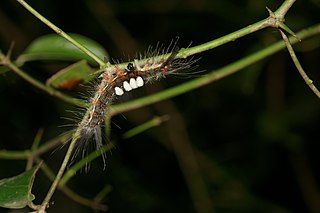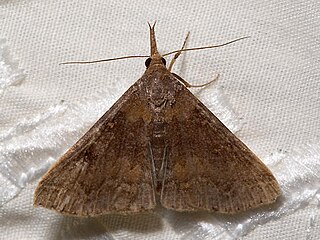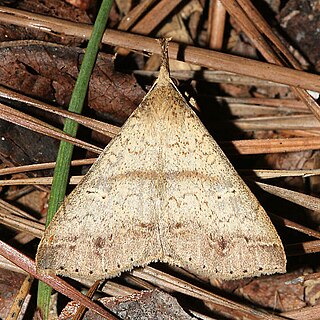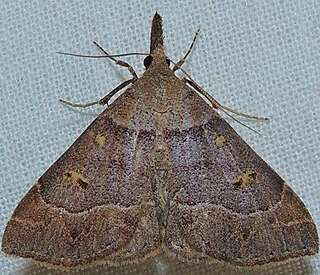
The Lymantriinae are a subfamily of moths of the family Erebidae. The taxon was erected by George Hampson in 1893.

The Herminiinae are a subfamily of moths in the family Erebidae. The members of the subfamily are called litter moths because the caterpillars of most members feed on dead leaves of plants, though others feed on living leaves.

Renia is a genus of litter moths of the family Erebidae erected by Achille Guenée in 1854.

Zanclognatha is a genus of litter moths of the family Erebidae. The genus was erected by Julius Lederer in 1857.
Idia majoralis, the greater idia, is a litter moth of the family Erebidae. The species was first described by J. B. Smith in 1895. It is found in Canada from Ontario and Quebec, south into the United States, where it has been recorded from Illinois, Wisconsin and Missouri.
Phalaenostola hanhami, also called Hanham's owlet or Hanham's snout moth, is a litter moth of the family Erebidae. The species was first described by J. B. Smith in 1899. It is found in North America from Nova Scotia, west across Canada to central Alberta, south to Massachusetts and New York.

Tetanolita floridana, the Florida owlet or Florida tetanolita moth, is a litter moth of the family Erebidae. The species was first described by J. B. Smith in 1895. It is found in the United States from Wisconsin to Long Island, south to Florida and Texas.

Renia discoloralis, the discolored renia, is a litter moth of the family Erebidae. The species was first described by Achille Guenée in 1854. It is found in the United States from Missouri to southern New England, south to at least North Carolina and possibly Florida and Texas, but this might be an unnamed relative.

Renia salusalis, the dotted renia, is a litter moth of the family Erebidae. The species was first described by Carl Linnaeus in his 1758 10th edition of Systema Naturae. It is found in the United States from Colorado, Ohio and Connecticut, south to Florida and Texas.

Renia adspergillus, the gray renia or speckled renia moth, is a litter moth of the family Erebidae. The species was first described by Louis Augustin Guillaume Bosc in 1800. It is found in North America from Michigan to Quebec and south to Louisiana and Florida.

Renia factiosalis, the dark-banded renia or sociable renia moth, is a litter moth of the family Erebidae. The species was first described by Francis Walker in 1859. It is found from southern Canada to Florida and Texas.

Renia flavipunctalis, the yellow-dotted renia, yellow-spotted renia or even-lined renia, is a litter moth of the family Erebidae. The species was first described by Carl Geyer in 1832. It is found from southern Canada to Florida and Texas.
Renia nemoralis, the tardy renia or chocolate renia moth, is a litter moth of the family Erebidae. It is found in the US from Illinois to south-eastern Massachusetts south to Florida and Texas. The species was first described by William Barnes and James Halliday McDunnough in 1918.
Forbes' renia is a moth of the family Noctuidae. It is found in the United States from the Delaware Bay region of New Jersey, southward into Gulf states.
Renia mortualis is a litter moth of the family Erebidae. It is found in North America, including and possibly limited to the Huachuca Mountains of Arizona. The species was first described by William Barnes and James Halliday McDunnough in 1912.
Renia subterminalis is a litter moth of the family Erebidae. It is found in North America, including and possibly limited to the Huachuca Mountains of Arizona. The species was first described by William Barnes and James Halliday McDunnough in 1912.

Renia sobrialis, the sober renia, is a litter moth of the family Erebidae. The species was first described by Francis Walker in 1859. It is found from Nova Scotia to Florida, west to Mississippi and Minnesota.
The Catholic Benevolent Legion was a Roman Catholic benevolent society providing life insurance founded in New York in 1881. A parallel Catholic Women's Benevolent Legion was founded in 1895. The Legion merged with the Knights of Columbus in 1969.
Rubus fraternalis is an uncommon North American species of flowering plant in the rose family. It has been found in Québec and in the northeastern United States.
This page is based on this
Wikipedia article Text is available under the
CC BY-SA 4.0 license; additional terms may apply.
Images, videos and audio are available under their respective licenses.











